Qianyi Jiang
Marten: Visual Question Answering with Mask Generation for Multi-modal Document Understanding
Mar 18, 2025Abstract:Multi-modal Large Language Models (MLLMs) have introduced a novel dimension to document understanding, i.e., they endow large language models with visual comprehension capabilities; however, how to design a suitable image-text pre-training task for bridging the visual and language modality in document-level MLLMs remains underexplored. In this study, we introduce a novel visual-language alignment method that casts the key issue as a Visual Question Answering with Mask generation (VQAMask) task, optimizing two tasks simultaneously: VQA-based text parsing and mask generation. The former allows the model to implicitly align images and text at the semantic level. The latter introduces an additional mask generator (discarded during inference) to explicitly ensure alignment between visual texts within images and their corresponding image regions at a spatially-aware level. Together, they can prevent model hallucinations when parsing visual text and effectively promote spatially-aware feature representation learning. To support the proposed VQAMask task, we construct a comprehensive image-mask generation pipeline and provide a large-scale dataset with 6M data (MTMask6M). Subsequently, we demonstrate that introducing the proposed mask generation task yields competitive document-level understanding performance. Leveraging the proposed VQAMask, we introduce Marten, a training-efficient MLLM tailored for document-level understanding. Extensive experiments show that our Marten consistently achieves significant improvements among 8B-MLLMs in document-centric tasks. Code and datasets are available at https://github.com/PriNing/Marten.
A Token-level Text Image Foundation Model for Document Understanding
Mar 04, 2025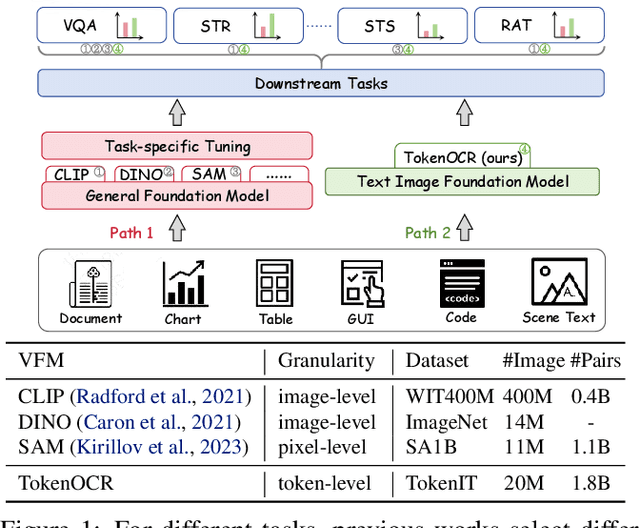
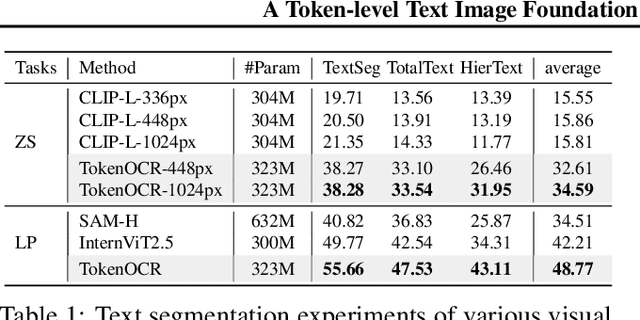
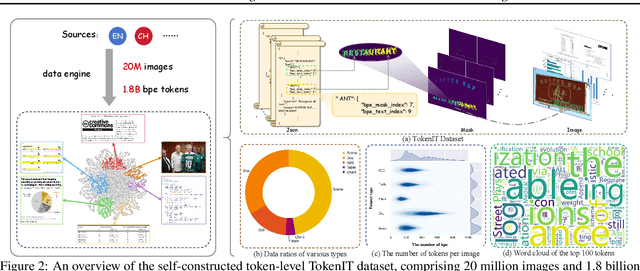

Abstract:In recent years, general visual foundation models (VFMs) have witnessed increasing adoption, particularly as image encoders for popular multi-modal large language models (MLLMs). However, without semantically fine-grained supervision, these models still encounter fundamental prediction errors in the context of downstream text-image-related tasks, i.e., perception, understanding and reasoning with images containing small and dense texts. To bridge this gap, we develop TokenOCR, the first token-level visual foundation model specifically tailored for text-image-related tasks, designed to support a variety of traditional downstream applications. To facilitate the pretraining of TokenOCR, we also devise a high-quality data production pipeline that constructs the first token-level image text dataset, TokenIT, comprising 20 million images and 1.8 billion token-mask pairs. Furthermore, leveraging this foundation with exceptional image-as-text capability, we seamlessly replace previous VFMs with TokenOCR to construct a document-level MLLM, TokenVL, for VQA-based document understanding tasks. Finally, extensive experiments demonstrate the effectiveness of TokenOCR and TokenVL. Code, datasets, and weights will be available at https://token-family.github.io/TokenOCR_project.
Multimodal Large Language Models for Text-rich Image Understanding: A Comprehensive Review
Feb 23, 2025Abstract:The recent emergence of Multi-modal Large Language Models (MLLMs) has introduced a new dimension to the Text-rich Image Understanding (TIU) field, with models demonstrating impressive and inspiring performance. However, their rapid evolution and widespread adoption have made it increasingly challenging to keep up with the latest advancements. To address this, we present a systematic and comprehensive survey to facilitate further research on TIU MLLMs. Initially, we outline the timeline, architecture, and pipeline of nearly all TIU MLLMs. Then, we review the performance of selected models on mainstream benchmarks. Finally, we explore promising directions, challenges, and limitations within the field.
InstructOCR: Instruction Boosting Scene Text Spotting
Dec 20, 2024Abstract:In the field of scene text spotting, previous OCR methods primarily relied on image encoders and pre-trained text information, but they often overlooked the advantages of incorporating human language instructions. To address this gap, we propose InstructOCR, an innovative instruction-based scene text spotting model that leverages human language instructions to enhance the understanding of text within images. Our framework employs both text and image encoders during training and inference, along with instructions meticulously designed based on text attributes. This approach enables the model to interpret text more accurately and flexibly. Extensive experiments demonstrate the effectiveness of our model and we achieve state-of-the-art results on widely used benchmarks. Furthermore, the proposed framework can be seamlessly applied to scene text VQA tasks. By leveraging instruction strategies during pre-training, the performance on downstream VQA tasks can be significantly improved, with a 2.6% increase on the TextVQA dataset and a 2.1% increase on the ST-VQA dataset. These experimental results provide insights into the benefits of incorporating human language instructions for OCR-related tasks.
ODM: A Text-Image Further Alignment Pre-training Approach for Scene Text Detection and Spotting
Mar 01, 2024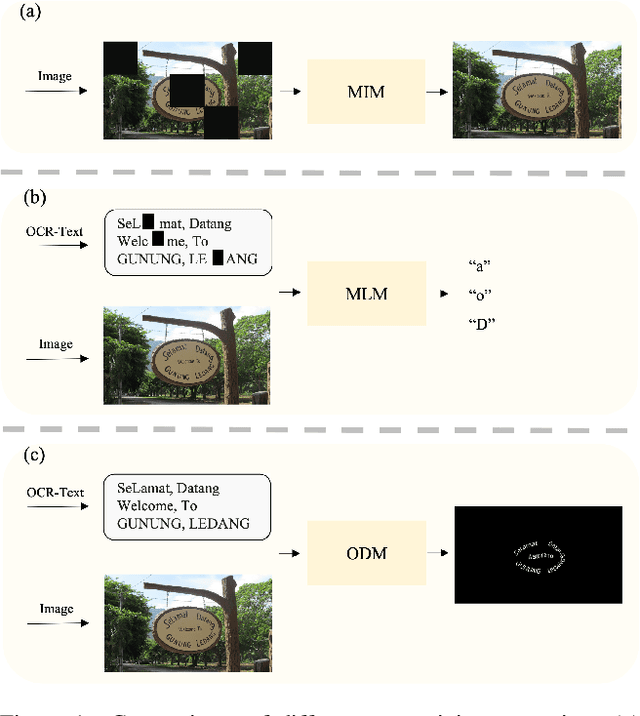

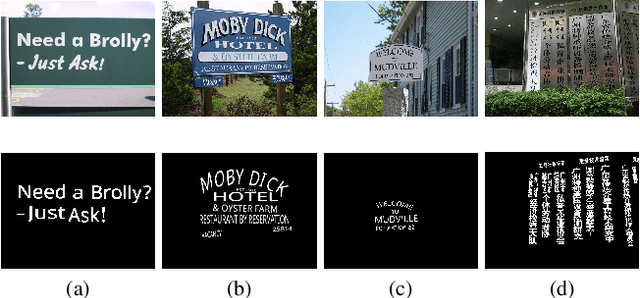

Abstract:In recent years, text-image joint pre-training techniques have shown promising results in various tasks. However, in Optical Character Recognition (OCR) tasks, aligning text instances with their corresponding text regions in images poses a challenge, as it requires effective alignment between text and OCR-Text (referring to the text in images as OCR-Text to distinguish from the text in natural language) rather than a holistic understanding of the overall image content. In this paper, we propose a new pre-training method called OCR-Text Destylization Modeling (ODM) that transfers diverse styles of text found in images to a uniform style based on the text prompt. With ODM, we achieve better alignment between text and OCR-Text and enable pre-trained models to adapt to the complex and diverse styles of scene text detection and spotting tasks. Additionally, we have designed a new labeling generation method specifically for ODM and combined it with our proposed Text-Controller module to address the challenge of annotation costs in OCR tasks, allowing a larger amount of unlabeled data to participate in pre-training. Extensive experiments on multiple public datasets demonstrate that our method significantly improves performance and outperforms current pre-training methods in scene text detection and spotting tasks. Code is available at {https://github.com/PriNing/ODM}.
ReADS: A Rectified Attentional Double Supervised Network for Scene Text Recognition
Apr 07, 2020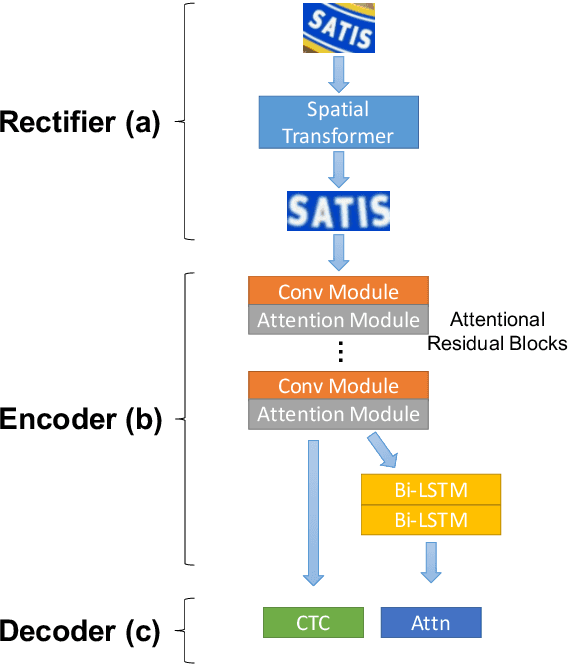
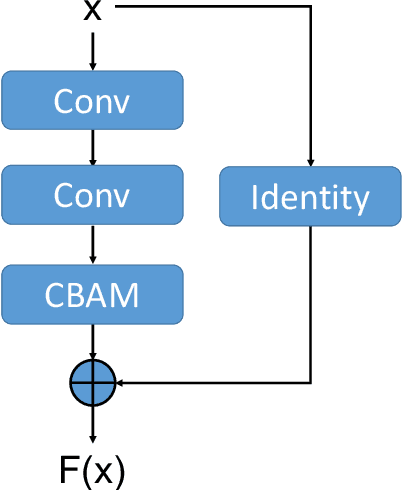
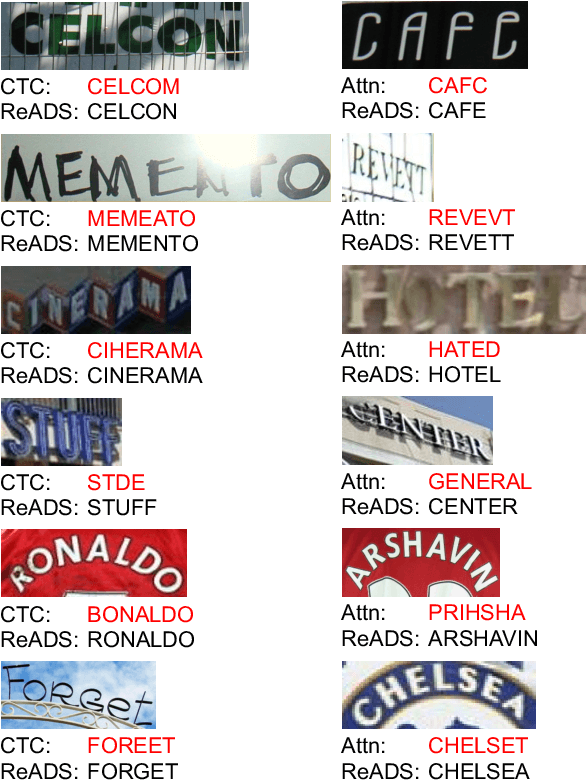
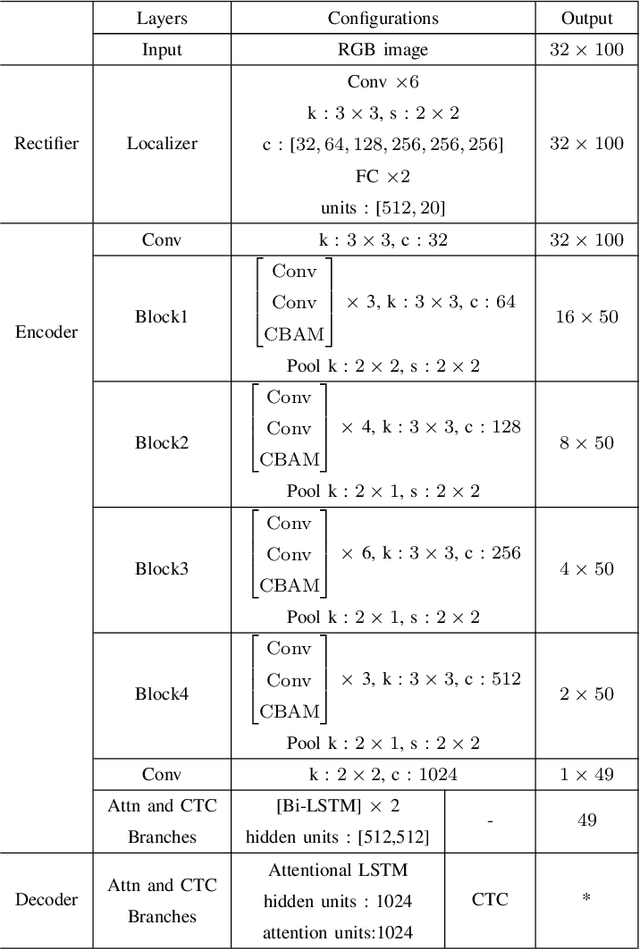
Abstract:In recent years, scene text recognition is always regarded as a sequence-to-sequence problem. Connectionist Temporal Classification (CTC) and Attentional sequence recognition (Attn) are two very prevailing approaches to tackle this problem while they may fail in some scenarios respectively. CTC concentrates more on every individual character but is weak in text semantic dependency modeling. Attn based methods have better context semantic modeling ability while tends to overfit on limited training data. In this paper, we elaborately design a Rectified Attentional Double Supervised Network (ReADS) for general scene text recognition. To overcome the weakness of CTC and Attn, both of them are applied in our method but with different modules in two supervised branches which can make a complementary to each other. Moreover, effective spatial and channel attention mechanisms are introduced to eliminate background noise and extract valid foreground information. Finally, a simple rectified network is implemented to rectify irregular text. The ReADS can be trained end-to-end and only word-level annotations are required. Extensive experiments on various benchmarks verify the effectiveness of ReADS which achieves state-of-the-art performance.
ICDAR 2019 Robust Reading Challenge on Reading Chinese Text on Signboard
Dec 20, 2019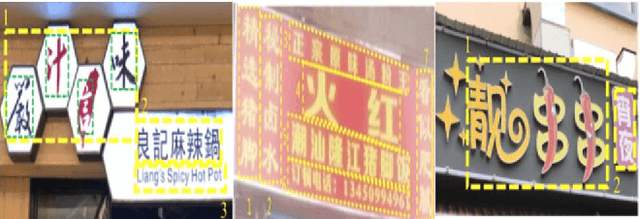
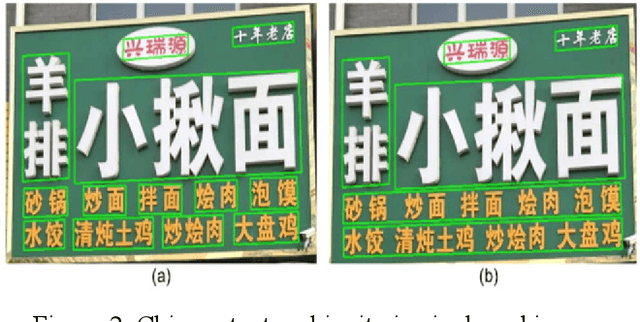


Abstract:Chinese scene text reading is one of the most challenging problems in computer vision and has attracted great interest. Different from English text, Chinese has more than 6000 commonly used characters and Chinesecharacters can be arranged in various layouts with numerous fonts. The Chinese signboards in street view are a good choice for Chinese scene text images since they have different backgrounds, fonts and layouts. We organized a competition called ICDAR2019-ReCTS, which mainly focuses on reading Chinese text on signboard. This report presents the final results of the competition. A large-scale dataset of 25,000 annotated signboard images, in which all the text lines and characters are annotated with locations and transcriptions, were released. Four tasks, namely character recognition, text line recognition, text line detection and end-to-end recognition were set up. Besides, considering the Chinese text ambiguity issue, we proposed a multi ground truth (multi-GT) evaluation method to make evaluation fairer. The competition started on March 1, 2019 and ended on April 30, 2019. 262 submissions from 46 teams are received. Most of the participants come from universities, research institutes, and tech companies in China. There are also some participants from the United States, Australia, Singapore, and Korea. 21 teams submit results for Task 1, 23 teams submit results for Task 2, 24 teams submit results for Task 3, and 13 teams submit results for Task 4. The official website for the competition is http://rrc.cvc.uab.es/?ch=12.
 Add to Chrome
Add to Chrome Add to Firefox
Add to Firefox Add to Edge
Add to Edge